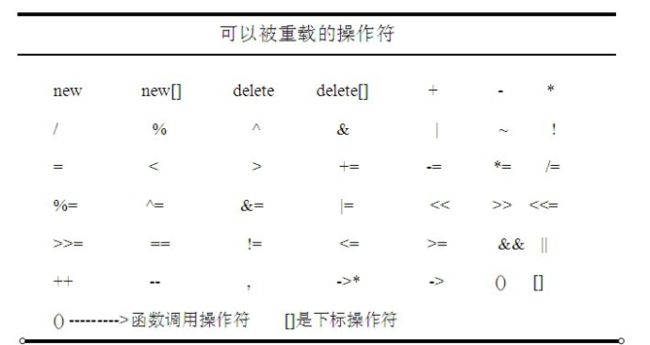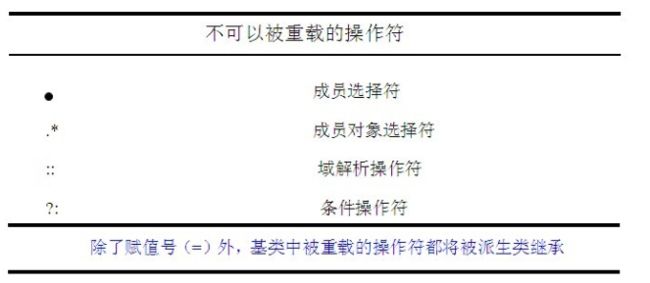C++实现复数类来学习运算符重载
C++里面有一个叫作运算符重载的特性,它其实是基于函数实现的,下面就来介绍一下运算符重载。
1、What
C++中预定义的运算符的操作对象只能是基本数据类型。但实际上,对于许多用户自定义类型(例如类),也需要类似的运算操作。这时就必须在C++中重新定义这些运算符,赋予已有运算符新的功能,使它能够用于特定类型执行特定的操作。运算符重载的实质是函数重载,它提供了C++的可扩展性,也是C++最吸引人的特性之一。
运算符重载函数的定义与其他函数的定义类似,惟一的区别是运算符重载函数的函数名是由关键字operator和其后要重载的运算符符号构成的。运算符函数定义的一般格式如下:
返回值 opreator 运算符(参数列表)
{
函数体
}
当然,并不是所有运算符都可以实现重载,下面列举了能实现重载和不能实现重载的运算符。

2、Notice
a. 不能通过连接其他符号来创建新的操作符:比如operator@;
b. 重载操作符必须有一个类类型或者枚举类型的操作数;
int operator +(const int _iNum1 , const int _iNum2 ) // 报错
{
return ( _iNum1 + _iNum2);
}
typedef enum TEST {one ,two ,three };
int operator+(const int _iNum1 , const TEST _test ) //正确
{
return _iNum1;
}c. 用于内置类型的操作符,其含义不能改变,例如:内置的整型+,不能改变其含义;
d. 不再具备短求值特性
重载操作符不能保证操作符的求值顺序,在重载&&和||中,对每个操作数都要进行求值,而且对操作数的求值顺序不能做规定,因此:重载&&、||和逗号操作符不是好的做法。
e. 作为类成员的重载函数,其形参看起来比操作数数目少1
成员函数的操作符有一个默认的形参this,限定为第一个形参。
CTest operator+(const CTest test1, const CTest test2)const // 报错
{
return test1;
}
CTest operator+(const CTest test1)const
{
return test1;
}f. 一般将算术操作符定义为非成员函数,将赋值运算符定义成员函数
g. 操作符定义为非类的成员函数时,一般将其定义为类的友元
h. == 和 != 操作符一般要成对重载
i.下标操作符[]:一个非const成员并返回引用,一个是const成员并返回引用
j. 解引用操作符*和->操作符,不显示任何参数
k. 自增自减操作符
前置式++/–必须返回被增量或者减量的引用
后缀式操作符必须返回旧值,并且应该是值返回而不是引用返回
l. 输入操作符>>和输出操作符<<必须定义为类的友元函数
3、Realize
通过一个复数类来深入认识运算符重载
#define _CRT_SECURE_NO_WARNINGS 1
#include <iostream>
using namespace std;
//实现复数类
class Complex
{
public:
Complex(const double real = 0.0, const double image = 0.0)
:_real(real)
, _image(image)
{
cout << "Create:" << this << endl;
}
Complex(const Complex& complex)
:_real(complex._real)
, _image(complex._image)
{
cout << "Copy Create:" << this << endl;
}
~Complex()
{
cout << "Destroy:" << this << endl;
}
void Print()
{
cout << "real:" << _real << " image:" << _image << endl;
}
//实现各个运算符的重载
//= + - * /
Complex& operator=(const Complex& complex)
{
if (this != &complex)
{
_real = complex._real;
_image = complex._image;
}
return *this;
}
Complex operator+(const Complex& complex)
{
return Complex(_real + complex._real, _image + complex._image);
}
Complex operator-(const Complex& complex)
{
return Complex(_real - complex._real, _image - complex._image);
}
Complex operator*(const Complex& complex)
{
//复数乘法:(a+bi) * (c+di) = (ac-bd)+ (ad+bc)i
return Complex((_real*complex._real - _image*complex._image), (_real*complex._image + _image*complex._real));
}
Complex operator/(const Complex& complex)
{
//复数除法:(a+bi) / (c+di) = (ac+bd)/(c*c+d*d) + (bc-ad)i/(c*c+d*d)
return Complex((_real*complex._real + _image*complex._image) / (complex._real*complex._real + complex._image*complex._image), \
(_image*complex._real - _real*complex._image) / (complex._real*complex._real + complex._image*complex._image));
}
//+= -= *= /=
Complex operator+=(const Complex& complex)
{
_real += complex._real;
_image += complex._image;
return *this;
}
Complex operator-=(const Complex& complex)
{
_real -= complex._real;
_image -= complex._image;
return *this;
}
Complex operator*=(const Complex& complex)
{
//因为下面的运算中用到的都是_real和_image的初始值,所以在这儿先把它们的初始值保存下来(temp2可以不用定义直接用_image)
double temp1 = _real;
double temp2 = _image;
_real = temp1*complex._real - temp2*complex._image;
_image = temp1*complex._image + temp2*complex._real;
return *this;
}
Complex operator/=(const Complex& complex)
{
double temp1 = _real;
double temp2 = _image;
_real = (temp1*complex._real + temp2*complex._image) / (complex._real*complex._real + complex._image*complex._image);
_image = (temp2*complex._real - temp1*complex._image) / (complex._real*complex._real + complex._image*complex._image);
return *this;
}
//> >= < <= == !=
bool operator>(const Complex& complex)
{
return _real > complex._real;
}
bool operator>=(const Complex& complex)
{
return _real >= complex._real;
}
bool operator<(const Complex& complex)
{
return _real < complex._real;
}
bool operator<=(const Complex& complex)
{
return _real <= complex._real;
}
//上面四个函数只比较实部是因为:复数实部不为0,那么此时它是一个虚数,无法比较大小,这儿只是为了说明这几个运算符的
//重载是如何实现的,没有实际的逻辑意义
bool operator ==(const Complex& complex)
{
return (_real == complex._real) && (_image == complex._image);
}
bool operator !=(const Complex& complex)
{
return (_real != complex._real) || (_image != complex._image);
}
//前置++ --
Complex& operator++()
{
_real++;
_image++;
return *this;
}
Complex& operator--()
{
_real--;
_image--;
return *this;
}
//后置++ --
Complex operator++(int)
{
//因为后置的++和--,是先赋值,再++或--,所以这儿用一个临时变量来记住变量的值,然后把该变量自加1,
//此时变量的值已经变了,但因为返回的是变量自加之前的值,所以整个表达式的值是该变量自加前的值
Complex temp(*this);
_real++;
_image++;
return temp;
}
Complex operator--(int)
{
Complex temp(*this);
_real--;
_image--;
return temp;
}
//逻辑运算 && || !
bool operator&&(const Complex& complex)
{
return ((_real != 0 || _image != 0) && (complex._real != 0 || complex._image != 0));
}
bool operator||(const Complex& complex)
{
return ((_real != 0 || _image != 0) || (complex._real != 0 || complex._image != 0));
}
bool operator!()
{
return !(_real != 0 || _image != 0);
}
private:
double _real;
double _image;
};
//Test Complex() / Complex(const Complex& complex) / ~Complex() / Print()
void TestFun1()
{
Complex c1;
Complex c2(1.1, 2.2);
Complex c3(c2);
c1.Print();
c2.Print();
c3.Print();
}
//Test operator= / operator+ / operator- / operator* / operator/
void TestFun2()
{
Complex c1(1.1, 2.2);
Complex c2(1.1, 2.2);
Complex c3(0.0, 0.0);
c3.operator=(c2);
Complex c4 = c1.operator+(c2);
Complex c5 = c1.operator-(c2);
Complex c6 = c1.operator*(c2);
Complex c7 = c1.operator/(c2);
c1.Print();
c2.Print();
c3.Print();
c4.Print();
c5.Print();
c6.Print();
c7.Print();
}
//Test operator+= / operator-= / operator*= / operator/=
void TestFun3()
{
Complex c1(1.1, 2.2);
Complex c2(0.0, 0.0);
Complex c3(0.0, 0.0);
Complex c4(1.0, 1.0);
Complex c5(1.1, 2.2);
c2.operator+=(c1);
c3.operator-=(c1);
c4.operator*=(c1);
c5.operator/=(c1);
c1.Print();
c2.Print();
c3.Print();
c4.Print();
c5.Print();
}
//Test operator> / operator>= / operator< / operator<= / operator== / operator!=
void TestFun4()
{
Complex c1(1.1, 2.2);
Complex c2(0.0, 0.0);
bool b1 = c1.operator>(c2);
bool b2 = c1.operator>=(c2);
bool b3 = c1.operator<(c2);
bool b4 = c1.operator<=(c2);
bool b5 = c1.operator==(c2);
bool b6 = c1.operator!=(c2);
cout << b1 << ' ' << b2 << ' ' << b3 << ' ' << b4 << ' ' << b5 << ' ' << b6 << endl;
}
//Test operator++() / operator++(int) / operator--() / operator--(int)
void TestFun5()
{
Complex c1(1.1, 2.2);
Complex c2(1.1, 2.2);
Complex temp(0.0, 0.0);
//因为要是直接用c1或c2输出,那么在输出时c1、c2的值已经是++或--运算的下一次使用了,因此用temp记住使用前的值
temp.operator=(c1.operator++());
temp.Print();
temp.operator=(c1.operator++(1));
temp.Print();
temp.operator=(c2.operator--());
temp.Print();
temp.operator=(c2.operator--(1));
temp.Print();
}
//Test operator&& / operator|| / operator!
void TestFun6()
{
Complex c1(1.1, 2.2);
Complex c2(0.0, 0.0);
bool b1 = c1.operator&&(c2);
bool b2 = c1.operator||(c2);
bool b3 = c2.operator!();
cout << b1 << ' ' << ' ' << b2 << ' ' << b3 << endl;
}
int main()
{
//TestFun1();
//TestFun2();
TestFun3();
//TestFun4();
//TestFun5();
//TestFun6();
getchar();
return 0;
}